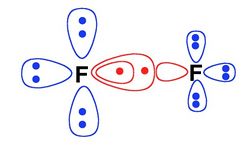Différences entre les versions de « The SD BOVB method »
Aller à la navigation
Aller à la recherche

| Ligne 2 : | Ligne 2 : | ||
| + | <big> | ||
| − | + | === Definition of the S-BOVB level === | |
| + | The "S" in the name means "splitted". At this level, in each VB structure, all the active orbitals which are doubly occupied at the L-BOVB level are "splitted", that is to say they are replaced by a pair of singlet-coupled electrons in two ''different'' orbitals located on the same center. Here is below a pictorial example for the F<sup>-</sup>F<sup>+</sup> ionic structure of difluorine dimer. This allows the inclusion of some more dynamical correlation (radial correlation) for the active electron pairs. | ||
| + | |||
| + | <center>[[File:F%2BF-.jpg|250px]]</center> | ||
| + | |||
| + | </big> | ||
---- | ---- | ||
Version du 5 juillet 2012 à 11:14
<<< Back to the "general guidelines for BOVB calculations"
Definition of the S-BOVB level
The "S" in the name means "splitted". At this level, in each VB structure, all the active orbitals which are doubly occupied at the L-BOVB level are "splitted", that is to say they are replaced by a pair of singlet-coupled electrons in two different orbitals located on the same center. Here is below a pictorial example for the F-F+ ionic structure of difluorine dimer. This allows the inclusion of some more dynamical correlation (radial correlation) for the active electron pairs.
